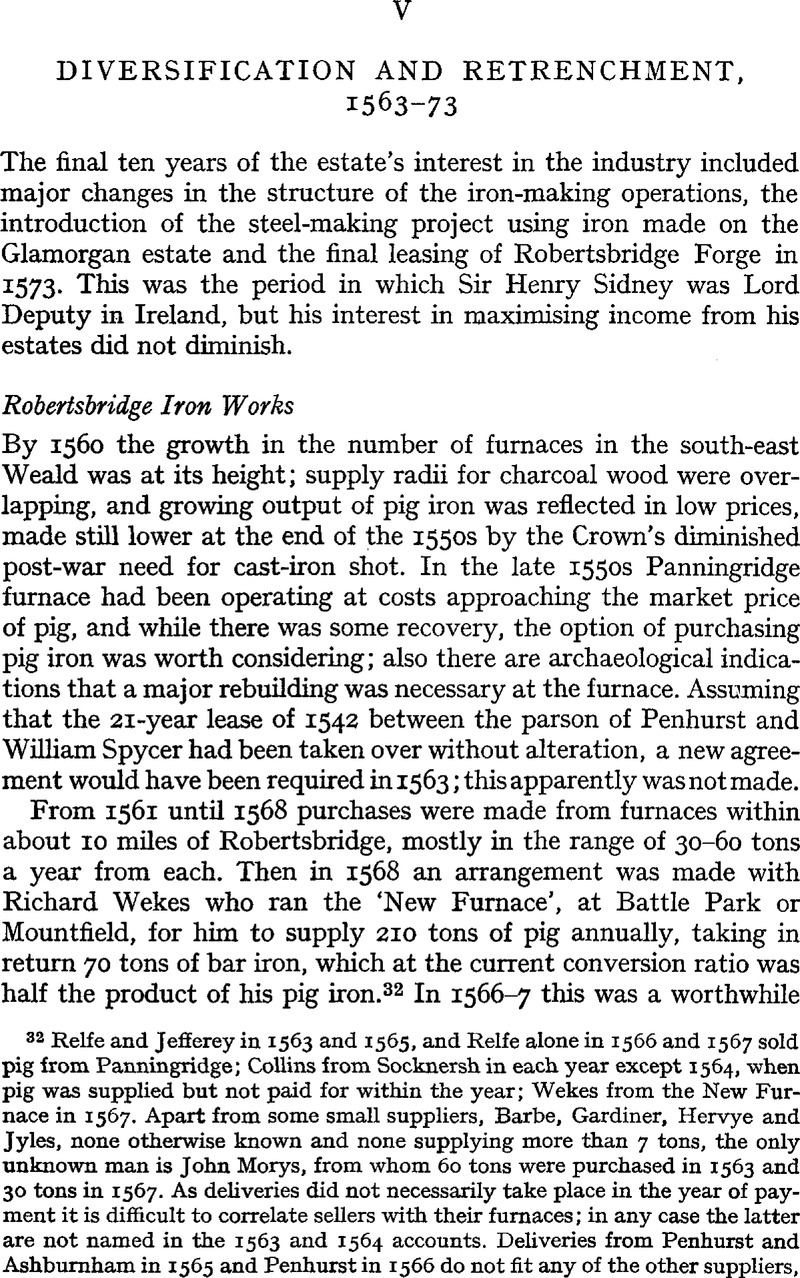No CrossRef data available.
Article contents
V Diversification and Retrenchment, 1563–73
Published online by Cambridge University Press: 21 December 2009
Abstract

- Type
- Introduction
- Information
- Copyright
- Copyright © Royal Historical Society 1975
References
page 30 note 32 Relfe and Jefferey in 1563 and 1565, and Relfe alone in 1566 and 1567 sold pig from Panningridge; Collins from Socknersh in each year except 1564, when pig was supplied but not paid for within the year; Wekes from the New Furnace in 1567. Apart from some small suppliers, Barbe, Gardiner, Hervye and Jyles, none otherwise known and none supplying more than 7 tons, the only unknown man is John Morys, from whom 60 tons were purchased in 1563 and 30 tons in 1567. As deliveries did not necessarily take place in the year of payment it is difficult to correlate sellers with their furnaces; in any case the latter are not named in the 1563 and 1564 accounts. Deliveries from Penhurst and Ashburnham in 1565 and Penhurst in 1566 do not fit any of the other suppliers, and it is just possible that these are attributable to Morys. Whether he was a lessee of Ashburnham furnace and this iron was made there is not clear, so this can only be a tentative suggestion. It is not known when the Mountfield furnace was built; it appears in the 1574 lists (Straker, p. 326). It is closer to Robertsbridge than Wekes' Battle Park furnace. The furnace at Beech (Straker, p. 325) is also a possibility. Schubert (History, pp. 367–8Google Scholar) infers, without proof, that Wekes made pig for Robertsbridge here.
page 31 note 33 Receipts of rents for the ironworks appear in (H.M.C.) 150, 155, 165 and 273. The problem of the acceptability of the returns to the 1588 enquiry into Wealden ironworks is dealt with in Cattell, C. S., ‘An Evaluation of the Loseley List of Ironworks within the Weald in the Year 1588’, Archaeologia Cantiana, lxxxvi (1971), pp. 85–92.Google Scholar
page 32 note 34 Schubert, , History, pp. 192, 229, 233, 385Google Scholar. Fragmentary Accounts for 1700–2 survive in the De L'Isle collection (U 1475 B 18/1–3).
page 32 note 35 Bevan, T., ‘Sussex Ironmasters in Glamorgan’, Trans. Cardiff Naturalists' Soc, lxxxvi (1965–1967), pp. 5–12Google Scholar, confuses these activities with the Sidneys' interests in the Bridgend area after 1584. W. Llewellin (Archaeologia Cambrensis, 3rd ser., ix (1863), pp. 81–119Google Scholar) does not refer to the Sidneys' operations.
page 32 note 36 Schubert, , History, p. 319Google Scholar, lists the consumption of raw materials, but transposes the amounts for plates and pig. His suggestion that there was a higher proportion of ore to charcoal in the charge and thus a lower carbon content in the plates therefore seems unsound.
page 33 note 37 Two early furnaces whose sites are noted by Rees, D. Morgan in ‘Industrial Archaeology in Wales’, Archaeologia Cambrensis, cxiii (1964), pp. 129–49Google Scholar, are at Cwm Amman (N.G.R. 004992) and Blaincanaid (042048). Both seem too far from Cardiff to correspond with the cost of carriage.
page 33 note 38 Boxhurst is a farm south east of Sandhurst. It lies about two miles from Bodiam Bridge, where iron plates from Glamorgan and finished steel for London were trans-shipped. No trace of steelworks have been found on the ground. I am grateful to Mr. D. Hemsley for arranging field investigations in this area.
page 33 note 39 Jenkins, Rhys, ‘Notes on the Early History of Steelmaking in England’, Trans. Newcomen Society, iii (1924), pp. 16–40Google Scholar; Schubert, H. R., ‘The Economic Aspects of Sir Henry Sidney's Steelworks …’, Jnl. Iron and Steel Institute, clxiv (1950), pp. 278–80Google Scholar; see also Schubert, , History, pp. 315–21.Google Scholar
page 34 note 40 P.R.O., C66/1052.
page 34 note 41 Jenkins, Rhys, op. cit., pp. 17, 33Google Scholar, states that the steelmakers had been engaged in 1564. Unless the manuscript has deteriorated at a key point this appears to be an error.
page 34 note 42 Schubert, , ‘The Economic Aspects of Sir Henry Sidney's Steelworks’, pp. 278–80.Google Scholar




